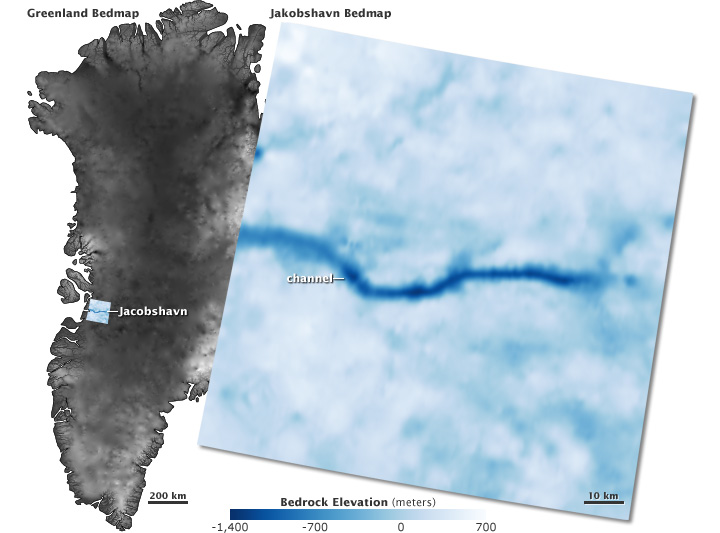


Greenland’s Jakobshavn glacier has the potential to influence sea level rise more than any other single feature in the Northern Hemisphere. Like a funnel, the large glacier channels ice from much of the Greenland ice sheet into the Atlantic Ocean, at a rate of about 15 kilometers per year. It is the world’s fastest flowing glacier.
Why do some glaciers, like Jakobshavn, feed ice into the ocean so quickly while others barely move at all? Answering that question is crucial because if we are to predict how much sea levels will rise as Earth warms, we have to know how much ice glaciers will deliver to the ocean. The key to predicting glacier flow is to map the ground beneath the ice—a concept described in the Earth Observatory’s new feature, IceBridge: Building a record of Earth’s changing ice, one flight at a time.
The shape of the land where a glacier meets the ocean influences how the glacier will behave, says Sophie Nowicki, a scientist at NASA's Goddard Space Flight Center who studies ice sheets using computer models. If the ground slopes downhill as you move inland from the ocean—or if the glacier is channeled through a deep canyon or fjord—then it’s a sure bet that the glacier will retreat quickly. In contrast, bumps or ridges beneath the glacier can act as pinning points and stop the retreat.
Jakobshavn, it turns out, flows through a deep canyon. The image on the right shows the shape of Jakobshavn’s bed based on radar measurements made by an instrument now flying on airplanes as part of NASA’s IceBridge mission. The instrument made these measurements on earlier flights, but additional flights on IceBridge continue to refine the picture. Dark blue reveals the deep channel through which Jakobshavn flows.
“Before IceBridge, this measurement of Jakobshavn was the best bed we had,” says Nowicki, pointing to a crude figure (image left) illustrating what was once the best picture of the ground beneath any glacier. “With much more data from the radar instrument (on IceBridge and earlier flights), we realized that the bed of Jakobshavn Isbrae is a channel that could be compared to the Grand Canyon. It’s the same width, the same depth.” Ice-flow models that use the new measurements of the Jakobshavn bed now match pretty closely with the real-world observations of its movements.
Because the new bed measurements improve ice-flow models, they will also help scientists understand how much ice could contribute to sea level rise in the future. With regular flights over the next six years, IceBridge will map out glacier beds throughout Greenland and Antarctica.
To read more, see the Earth Observatory’s new feature article on IceBridge.
Map by Robert Simmon, using data from the Bristol Glaciology Centre and the Center for Remote Sensing of Ice Sheets. Caption by Holli Riebeek.